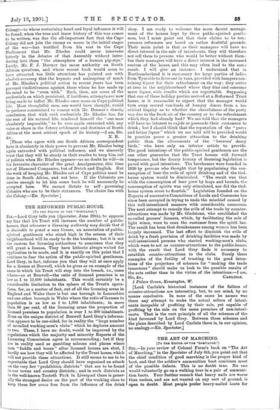THE ART OF MARCHING.
(TO TRX EDITOR OP THE "SPROTA.TOR.")
Six,—In your review of Colonel Purse's book on "The Art of Marching," in the Spectator of July 6th, you point out that the chief condition of good marching is the proper kind of boot, and that the soldier's ammunition boot combines most of the possible defects. This is no doubt true. No one would voluntarily go on a walking tour in a pair of ammuni- tion boots. Your further remark that heavy nails are worse than useless, and are not wanted on any sort of ground, is open to doubt. Moat people prefer heavy-nailed boots for shooting, and no one would trust himself on the grass of a Swiss alp in thin boots without nails. A boot is a cumber- some garment. It is bad at the end of the first day's march, when the foot swells from heat and fatigue ; it is cruelly bad on the second day, when the damp, ill-fitting leather searches out the worst places of a tender foot. Moreover, stiff and unyielding, it cramps the muscles of the foot and leg, and neutralises the steadiness that the prehensile power of the foot should give. What is wanted is a covering that shall protect the foot from wet and cold, and the inequalities of the ground, shall yield as the foot swells without the tendency to chafing that a loosely fitting boot is apt to give, and shall allow a firm foothold. This is provided by the footgear used by the peasants in the south-east of Europe,—in Hungary, Servia, &c. These men swathe the foot with strips of woollen material, and under- neath lash a thin leather sole. Englishmen who are wise adopt it there for shooting and such like ruposes, and find their power of walking increased 20 or 30 per cent. There is nothing to pinch the foot when it swells, and its flexibility allows the toes their holding power in climbing over rough ground. Moreover, the soldier cannot carry a second pair of boots, nor can he as a rule dry those he is using. He could carry a second pair of foot wrappings and soles, and could also more easily dry them. They would not look well on parade no doubt, and need not be used there ; but a regi- ment so shod could walk round a regiment in ammunition boots. You also say that nails gradually work out, and most people who have walked much in Switzerland know to their annoyance that it is so. I have got over the difficulty by having my boots made with a single sole, and when after a little use they have taken the shape of my foot comfortably a " clump " sole is added. But before the clump is put on the nails are driven into it and clinched on the inside. You can knock those nails off if you use sufficient force, but you
cannot draw them.—I am, Sir, &c., H. F. B.







































 Previous page
Previous page